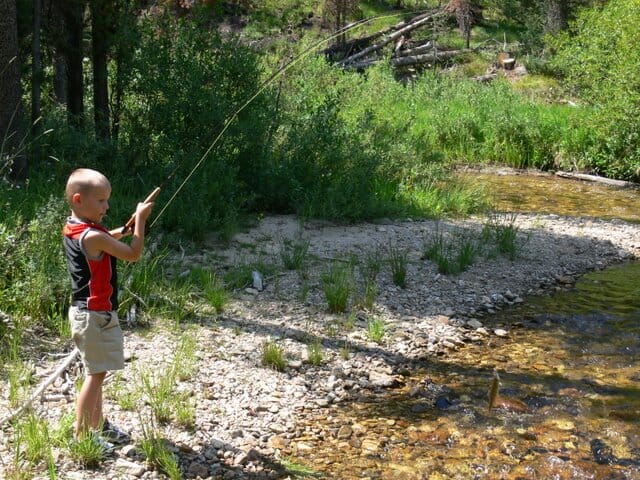Editor’s note: This is the second in an ongoing series meant to give those who are interested in learning to fly fish the perspective and advice needed to get started. More installments will follow. If you have specific questions about fly fishing, feel free to add a comment below, and we’ll do our best to answer them for you.
As a kid, my grandfathers were instrumental in getting me started fishing. Not fly fishing, exactly, but just plain, old fishing. As a kid, anything that offered up the chance of success tended to stick with me—being good at something mattered. So, wisely, my grandfathers (they were good friends with one another) started me, my brothers and my cousins fishing the easiest way they knew how.
If we fished streams for brook trout, they equipped us kids with fly rods, but not with all the traditional fly tackle. Rather than flies, we were given worms or grasshoppers. And our leaders were weighted with split shot. We were instructed to let line out by pulling it off the reel, and then using our off hands to pull the line tight while simply swinging the line upstream with our casting hand. We were instructed to do our best to keep the line tight as the baited hook drifted downstream toward us. I caught hundreds—maybe thousands—of small-stream trout using this method. Today, just to prove that fly fishing can be needlessly complex, it’s called Euro-nymphing and is often performed with longer, specialized fly rods that cost several hundred dollars and nymphs (or flies meant to imitate insects in their larval stages) instead of bait. Don’t fret. We’ll get to all that eventually.
If we fished lakes or ponds, we were given spinning rods with the simplest thumb-release casting reels our grandfathers could find. We were taught to cast baited hooks under bobbers into the deeper water, and we were instructed to keep our eyes on the bobber. It was an exercise in patience—some of us had it, and some of us didn’t.
As we matured, we would switch to lures and plugs on the lakes, and, in the streams, we were taught simple overhand fly casting using artificial flies instead of bait. Eventually, as time and desire dictated, a couple of us, for whom the sport took hold, took to simply fly fishing all the time, eschewing the spinning tackle. For me, it was just more fun.
Most people come to fly fishing through spin fishing out of a sense of simple curiousity. And, often, newcomers to fly fishing approach the craft as if they’re trying something completely different. Something foreign and strange.
That’s a mistake. Fly fishing and spin fishing aren’t all that dissimilar. Certainly, the method of delivery is different, and the the differences among bait and lures and flies is obvious. But the general concepts still apply. The ulitmate goal is identical. We fish to catch fish.
If you’re a spin-fishing angler who looks at fly fishing with some health skepticism, that’s a good thing. At least you’re interested. But know this: If you fish, you have a head start on folks who simply take up fly fishing having never fished before. As an angler, regardless of how you fish, you likely understand some of the most foundational concepts of fly fishing. If you fish moving water, you likely know how to read it, or you at least know where fish are likely to hold. You likely undertand the importance of a tight line and know what it feels like when a fish hits. You probably have a good sense of timing, are a good judge of distance and have some solid eye-hand coordination skills.
Honestly, you’re most of the way there. A casting lesson may be all you need to really dive in.
Don’t approach fly fishing like it’s some massive undertaking—it’s not. It’s fishing, just like you’ve been doing all along, with a few added nuances. Stay tuned. More to come.
— Chris Hunt
Previous installments in this series:



